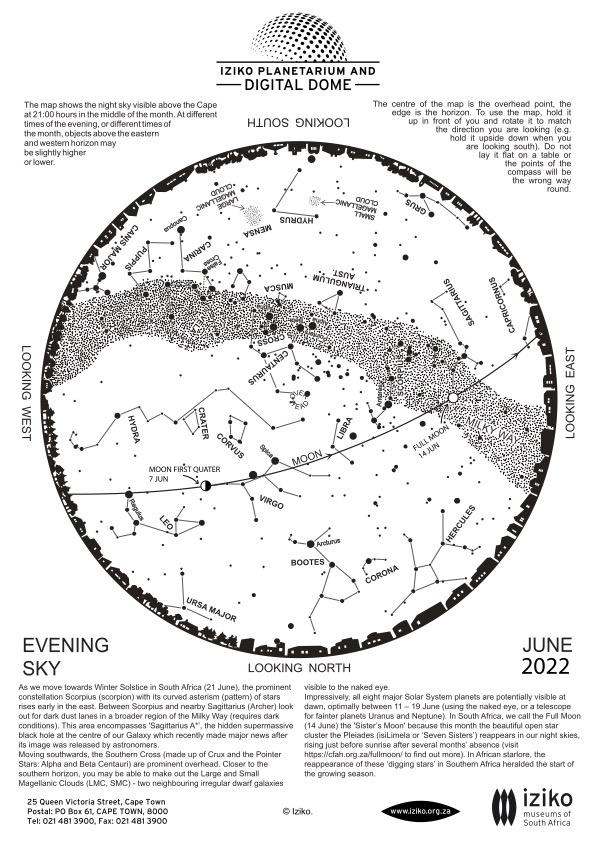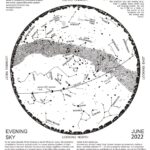
03 Jun Whats Up – June 2022
In a nutshell…
Moon
| Date | Time | Phase |
|---|---|---|
| 07/06 | 16h48 | First Quarter |
| 14/06 | 13h51 | Full Moon |
| 21/06 | 05h10 | Last Quarter |
| 29/06 | 04h52 | New Moon |
Moon – Earth Relations
Perigee: 357 432 km on the 15/06 at 01h23
Apogee: 406 580 km on the 29/06 at 08h08
The winter solstice will occur on the 21st of June at 11h13.
Planet Visibility
Mercury is visible in the morning sky near the stars of the constellation Taurus
Venus is visible in the morning sky near the stars of the constellation Taurus
Mars is visible in the morning sky near the stars of the constellation Pisces
Jupiter is visible in the morning sky near the stars of the constellation Pisces
Saturn is visible in the morning sky and is located near Capricornus
Meteor Showers
Two meteor showers are active in June, the theta-Ophiuchids and the June Lyrids. Observing prospects for both these showers are good. The theta-Ophiuchids are active from the 8th of June to the 16th of June, peaking on the 13th of June. They are best viewed between 20:00 p.m. and 05:30 a.m. looking between the constellations of Sagittarius, Scorpius and Ophiuchus.
The June Lyrids are active from the 11th of June to the 21st of June, peaking on the 16th. They are best viewed between 23:30 p.m. and 02:00 a.m. low down between NW and NE. They will appear to come from the general direction of the constellation Lyra (low in the north), but the longest trails will be visible about ¼ of the sky from here, either NW or NE or higher in the north.
Some easy to identify bright stars
Rigel: blue supergiant in Orion
Betelgeuse: red supergiant in Orion
Procyon: yellowish white star in Canis Minor
Sirius: brightest star in the night sky, located in Canis Major
Antares: red supergiant in Scorpius
Arcturus: red giant in Boötes
Spica: brightest bluish-white star in Virgo
Canopus: yellowish-white star in Carina
Altair: a white star, brightest in Aquila
Regulus: blue–white star and the brightest star in Leo
The Pointers: Alpha and Beta Centauri
Sun and Moon
The First Quarter falls on the 7th of June at 16h48 and the Full Moon occurs on the 14th of June at 13h51. The Last Quarter falls on the 21st of June at 05h10 and the New Moon occurs on the 29th of June at 04h52.
The Moon will be at perigee (closest approach to Earth) at a distance of about 357 432 km on the 15th of June at 01h23. The Moon will be at apogee (furthest from Earth) at a distance of about 406 580 km at 08h08.
The winter solstice will occur on the 21st of June at 11h13.
Planetary and Other Events – Morning and Evening
The five naked-eye planets and the two distant ice giants, namely Uranus and Neptune, are all visible in the morning skies this month. Wake up before sunrise, grab your coffee and enjoy observing the planets. Mercury, the smallest planet in the solar system, can be observed near the stars of the constellation Taurus. The planet reaches highest altitude on the 14th of June and is thus best located for observation. Mercury will be near the Moon on the 27th of June. Venus, the brightest planet, is also located near the stars of Taurus and is near the Moon on the 26th of June. Mars can be located near the stars of the constellation Pisces and will be near the Moon on the 26th of June. Mars is also near Pisces and will be near the Moon on the 22nd. Saturn is near the stars of Capricornus, and Jupiter is located near the stars of Pisces. Saturn and Jupiter will be near the Moon on the 18th and 21st, respectively. Check the five naked-eye planets lined up on a straight line on the 24th with the crescent Moon tagging along.
Two meteor showers are active in June, the theta-Ophiuchids and the June Lyrids. Observing prospects for both these showers are good. The theta-Ophiuchids are active from the 8th of June to the 16th of June, peaking on the 13th of June. They are best viewed between 20:00 p.m. and 05:30 a.m. looking between the constellations of Sagittarius, Scorpius and Ophiuchus. The June Lyrids are active from the 11th of June to the 21st of June, peaking on the 16th. They are best viewed between 23:30 p.m. and 02:00 a.m. low down between NW and NE. They will appear to come from the general direction of the constellation Lyra (low in the north), but the longest trails will be visible about ¼ of the sky from here, either NW or NE or higher in the north.
The Evening Sky Stars
Leo the Lion’s upside-down question mark should be easy to spot in the NW early in the evening, with the right triangle of the Lion’s hindquarters and tail following in the NNW. Bright orange Arcturus guards the Great Bear (invisible from the Cape except for its feet) from the NE, with the dimmer semicircle of the Northern Crown a bit to the right for an observer looking N.
Snaking its way across the sky above the constellations of the Lion, the Virgin and the Crow is the great water monster Hydra, with lonely Alphard at its heart fairly high in the NW at the beginning of evening. Alphard is an orange giant star, 175 light years away and 400 times as bright as our Sun. If Alphard was at the centre of our solar system, it would extend halfway to the orbit of Mercury, and we would be toast. Arcturus is a similar star, also an orange giant, which appears brighter in our skies because it’s only 37 light years away – but in fact it is only half as bright as Alphard. It’s always a good idea to remember that the universe is NOT two-dimensional, but that stars are at varying distances from us!
By month-end the Milky Way follows a path from west to ESE across the southern sky, with the bright stars Sirius and Canopus nearby in the W and SW, and the Large Dog, the great ship Argo, the Cross, the Fly, the Centaur, the Wolf, and the Scorpion tangled in the Milky Way itself. By late June the centre of our Milky Way has begun to rise even in early evening, and by late evening in winter the Milky Way is at its most majestic, with the centre of the galaxy passing nearly overhead. Notice the way the brighter stars are mostly in a belt almost, but not quite, coinciding with the Milky Way. This is ‘Gould’s Belt’, showing where young stars in our part of the galaxy have been forming in the last few million years. From outside, our Milky Way galaxy would look like a glowing pancake with a lump in the middle, but the pancake would not be perfectly flat – some parts would appear slightly tilted or warped. Below the Milky Way are the bright stars Canopus in the SW and Achernar (very low in the SSW), the ‘horn’ and ‘little horn’ stars of African legend.
The Morning Sky Stars
By morning, the Milky Way has nearly set, running near the horizon from north through the west into the south. Deneb shines in the NW predawn skies of early June, marking the top of the Northern Cross, with bright Vega near the northwestern horizon. In the WNW, Altair is the brightest of the stars of Aquila the Eagle, flying southward through the Milky Way. Low in the WSW and SW are the stars of the Archer and the Scorpion, with the stars of the Pointers and the Cross low in the SSW and S as seen from the Cape. From northern South Africa they will typically be invisible.
Almost overhead in the predawn sky at the beginning of the month is the Southern Fish with its brightish star Fomalhaut (‘mouth of the fish’), the 18th brightest star in the night sky. It’s only 25 light years away and about 16 times brighter than our sun. Around it is a celestial doughnut, a giant disk of icy dust four times the diameter of our solar system. But the centre, around the star itself, is largely free of this material, possibly because planet formation has swept this area clean.
To the south of Fomalhaut are the stars of the Crane, with bright Achernar a bit further southeast. Canopus rises low in the SE before the Sun in early June, and by late June bright Sirius is visible low in the ESE as well, while Orion can be seen low in the east before sunrise.
High in the northern sky are the stars of the Great Square of Pegasus. The Fishes are above and to the right of the Square (tied together by their tails). Beyond the Fishes, high in the NNE sky, is the Whale. With the Water Bearer and the Sea Goat to the SW of Pegasus, and the Southern Fish nearly overhead, this is a fairly waterlogged part of the sky!
Sivuyile Manxoyi
sivuyile@saao.ac.za
Twitter: @rassivuyile
The evening sky over Cape Town
The evening sky over Johannesburg

